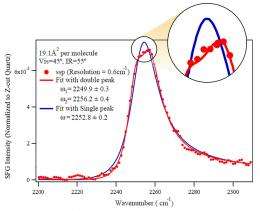EMSL's novel spectroscopy device pairs visual clarity with sub-monolayer sensitivity

Seeing details from a new angle can lead to game-changing discoveries. Using polarization-resolved sum-frequency generation vibrational spectroscopy (PS-SFG-VS) and a newly constructed sub-wavenumber high-resolution broadband SFG-VS (HR-BB-SFG-VS) capability available only at EMSL, scientists are uncovering new details about the structure and interactions in molecular monolayers and films, as well as showcasing how SFG spectral resolution and line shape in different polarization and incident angles are clarifying surface structure and intermolecular interactions.
EMSL staff and users from the Chinese Academy of Sciences analyzed polarization-dependent SFG vibrational spectra of the monovalent −CN groups buried in the C18CN (organic cyanide) insoluble Langmuir monolayer at the air–water interface.
These one-molecule-thick layers are the model system for studying structure and interactions at confined dimensions and serve as the building block for functional materials, as well as agents in broad industrial applications.
Because of its large dipoles and a vibrational spectrum that is sensitive to inhomogeneous chemical environments, –CN often is used as the probe in materials and biological studies. HR-BB-SFG-VS analyses of the C18CN monolayer revealed two previously indistinguishable vibrational spectroscopic −CN shifts that are distinct but closely overlapping at the more hydrophobic 2244.5 cm-1 and in direct contact with water at 2251.1 cm-1.
Polarization data pinned the orientation angles for these two −CN groups as 67° and 50°, respectively.
The unprecedented structural and interaction details afforded by HR-BB-SFG-VS—especially new knowledge about buried interfaces such as solid/liquid, liquid/liquid, and solid/solid, as well as on nanoparticles and porous surfaces—can impact areas such as catalysis, biogeological chemistry, and beyond.
More information: Zhang Z, et al. 2012. “Resolving Two Closely Overlapping -CN Vibrations and Structure in the Langmuir Monolayer of the Long-Chain Nonadecanenitrile by Polarization Sum Frequency Generation Vibrational Spectroscopy.” Journal of Physical Chemistry C 116(4):2976-2987. DOI: 10.1021/jp210138s
Journal information: Journal of Physical Chemistry C
Provided by Environmental Molecular Sciences Laboratory



















